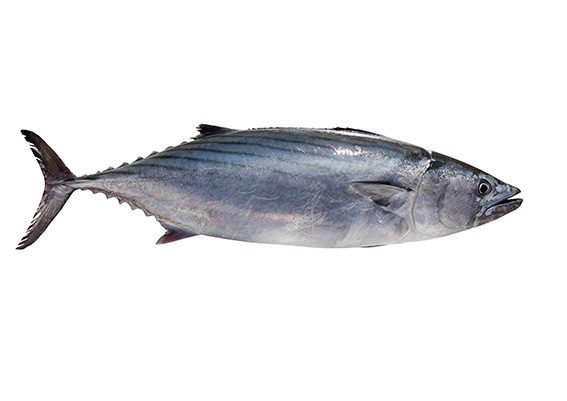
It differs from tuna in that it has long pectoral fins that can reach up to 30 cm.
The bonito (Sarda sarda) is a marine fish with an ossified skeleton. Elongated, slightly compressed body. Wide mouth with conical teeth. Wavy lateral line. The two dorsal wings are placed very close to each other. Back bluish, ventral side white. Can grow up to 90 cm long and weigh up to 10 kg.
It is a great predator of fish such as horse mackerel, sardines, mackerel and mullets. It can be found throughout the Mediterranean Sea and is fished from September to March. It is caught using different methods: purse seine, trammel nets, hand lines, trolling and longlines.
Its meat is very tasty, which makes it of great commercial interest, and allows for different preparations, both cooked and raw (in the latter it is recommended to have previously frozen it at -20º for 24 hours) and it is easy to clean and fillet because it has few bones. In addition, it provides the body with omega-3, which are polyunsaturated fatty acids that help regulate the level of cholesterol in the blood and also reduce the risk of cardiovascular diseases.

It differs from tuna in that it has long pectoral fins that can reach up to 30 cm.
The bonito (Sarda sarda) is a marine fish with an ossified skeleton. Elongated, slightly compressed body. Wide mouth with conical teeth. Wavy lateral line. The two dorsal wings are placed very close to each other. Back bluish, ventral side white. Can grow up to 90 cm long and weigh up to 10 kg.
It is a great predator of fish such as horse mackerel, sardines, mackerel and mullets. It can be found throughout the Mediterranean Sea and is fished from September to March. It is caught using different methods: purse seine, trammel nets, hand lines, trolling and longlines.
Its meat is very tasty, which makes it of great commercial interest, and allows for different preparations, both cooked and raw (in the latter it is recommended to have previously frozen it at -20º for 24 hours) and it is easy to clean and fillet because it has few bones. In addition, it provides the body with omega-3, which are polyunsaturated fatty acids that help regulate the level of cholesterol in the blood and also reduce the risk of cardiovascular diseases.
